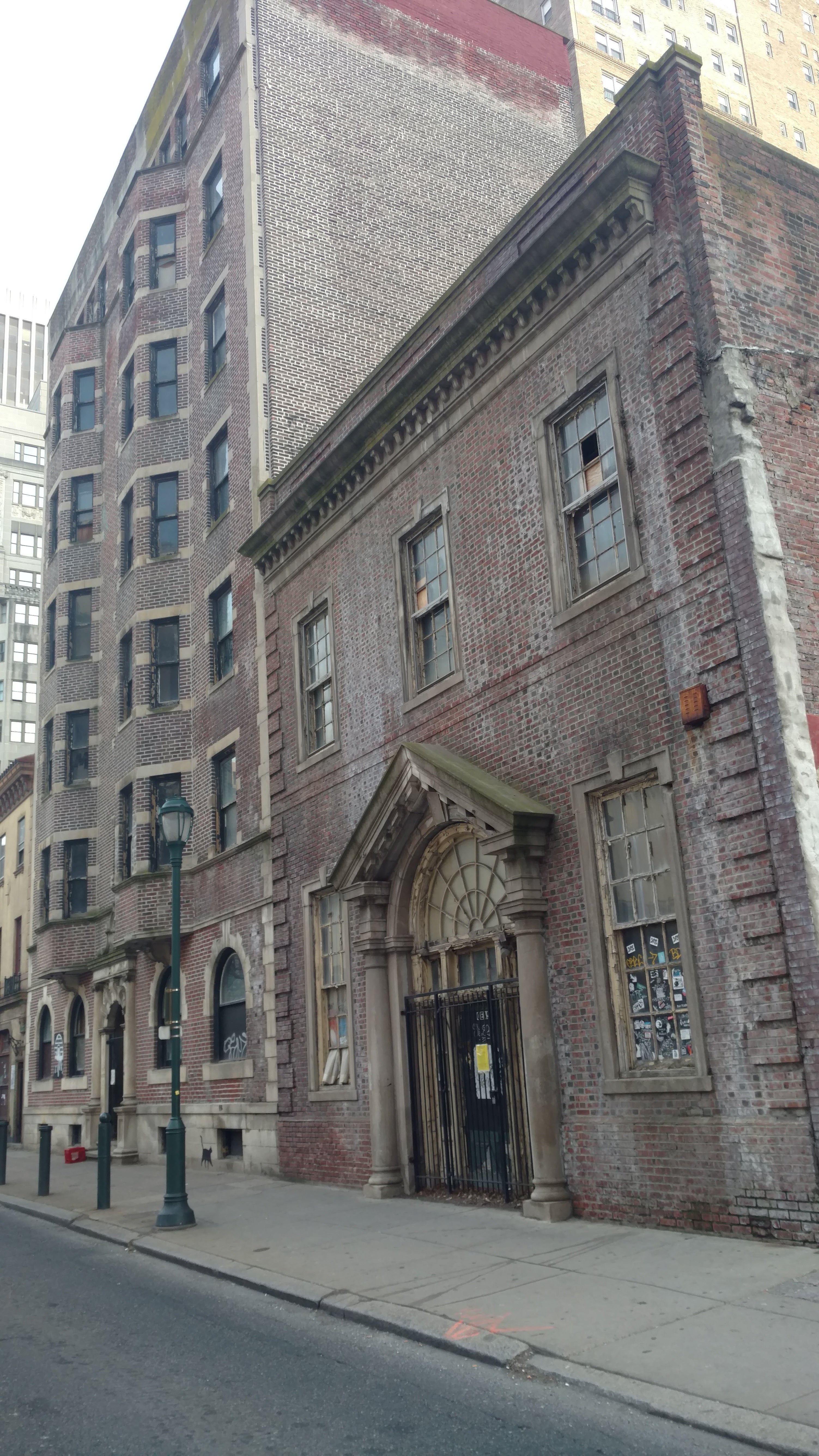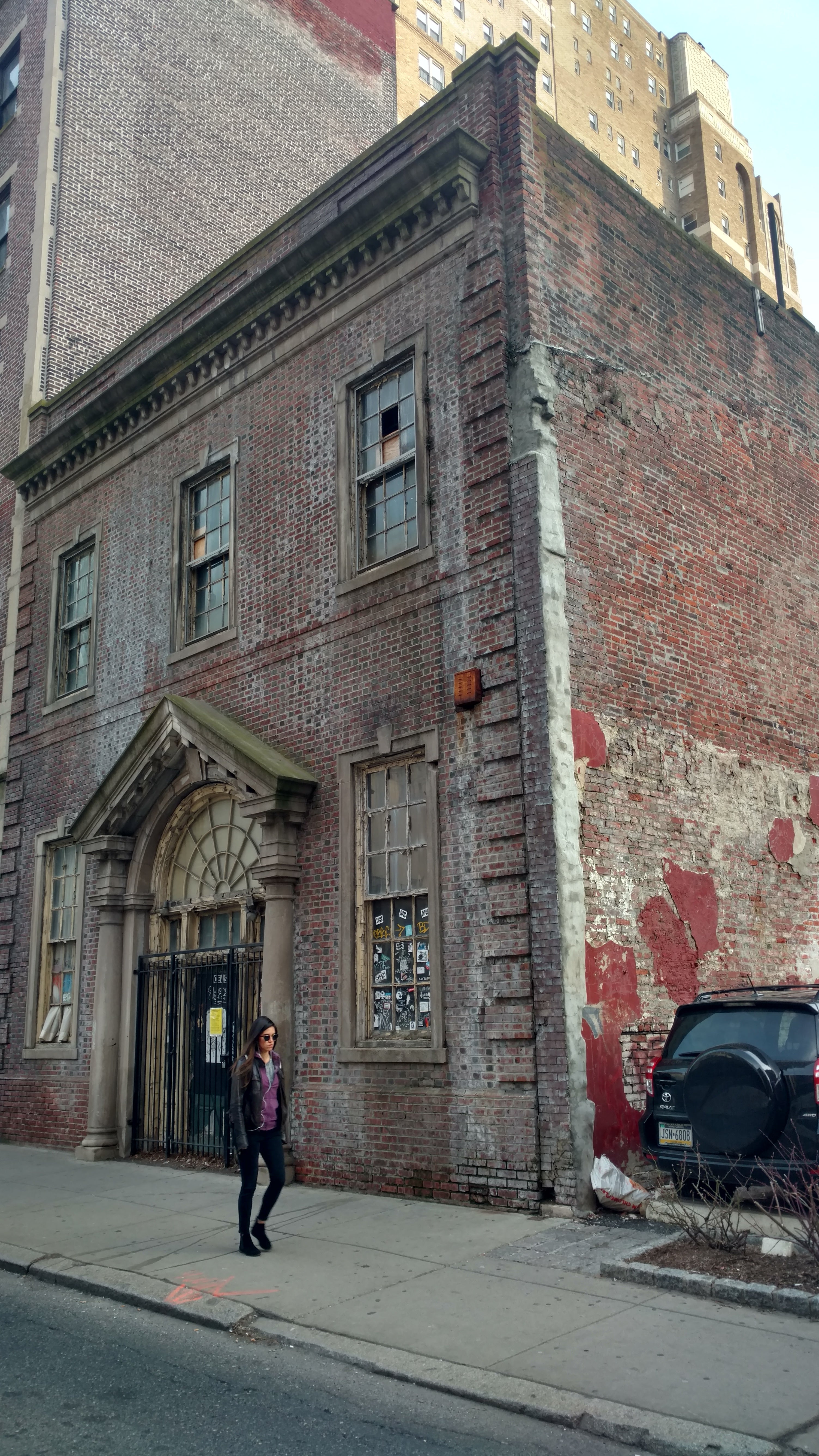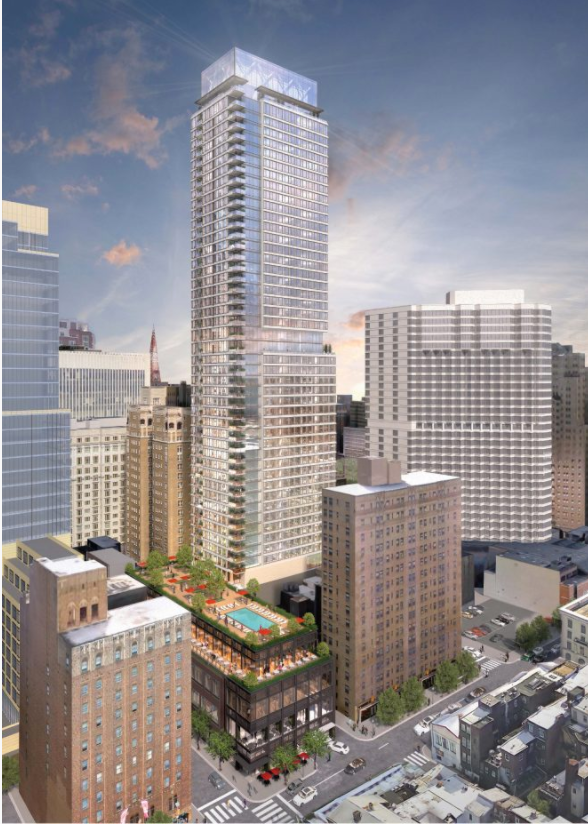1911 Walnut tower edges closer with preservation hardship relief in sight

On Wednesday, the Historical Commission held its first Hardship Committee hearing in almost two years, deciding the fate of the property at 1918-20 Sansom Street. Last used as the Oliver H. Bair funeral home, the 115-year old building is part of the Rittenhouse-Fitler Historic District. But Southern Land Company argues that the building is too far gone to be feasibly incorporated into their proposed residential skyscraper project at 1911 Walnut Street. In order to obtain permission from the Historical Commission to demolish the Bair building, Southern Land filed for a financial hardship.
After almost three hours of testimony, the Hardship Committee agreed that the Southern Land Company adequately demonstrated their financial hardship case. Committee members unanimously agreed that the building cannot be reasonably adapted, by any owner, for any purpose and that it would be futile to list it for sale separately from its neighbors in an attempt to find a different buyer.
Southern Land’s proposal for a new residential tower just off Rittenhouse Square would fill in one of the few remaining gaps around the public park. The footprint of the project is huge, spanning the depth of the block from Walnut to Sansom and reaching 19th Street.
When the proposal first became public in 2015, it called for the demolition of three buildings, including 1918-20 Sansom and its two neighbors to the immediate west: the former Warwick Apartments and the Rittenhouse Coffee shop.
All three were covered by the 1995 historic district, but had been vacant since 1997. The potential loss of these old buildings provoked community outcry, and Southern Land sought to accommodate advocates by agreeing to preserve the former coffee shop and the Warwick, with plans to donate the pair to Project HOME to use as affordable housing.
The anti-homelessness nonprofit would provide 35 efficiency apartments for people who live with incomes of less than 60 percent of area median income. Dustin Downey of Southern Land Company told the Hardship Committee that the units would be for those in even more desperate straits than that income restriction suggests, mostly going to people who were recently homeless. The developer will donate $2 million to the project in addition to the low-income housing tax credits being sought.
“It is our absolute plan, you have my word, we will deed restrict and redevelop both the Rittenhouse coffee shop and the Warwick Apartment homes as low income housing,” said Downey, who is the company’s senior vice president for multi-family development. “I can guarantee you that we will save the buildings.”
Downey claimed that the company tried numerous different formulations for incorporating the Oliver Baird building into the project, but they just couldn’t make it work. That position received supportive testimony of a battery of experts from organizations like Econsult Solutions.
These consultants testified that the damage to the building is too extensive, and that the interior would require extensive cleanup of mold, asbestos, and lead paint. They found that housing, retail, or hotel uses could not be placed in the building in such a way that would be profitable.
Downey added that the existing building actively prevented the successful financing of the project because it would be too expensive, financially impossible even, to incorporate the structure into the new tower complex off of Rittenhouse.
“It cuts off the project as a whole in a way the Warwick doesn’t, the coffee shop doesn’t,” said Downey. “It sits at the knuckle of where our lot goes to Walnut Street and where it comes out. Any major preservation of this site isn’t only fundamentally infeasible, but destroys the project as a whole because it cuts off the two sites and separates them.”
The Preservation Alliance for Greater Philadelphia and most other preservation advocates did not oppose Southern Land’s hardship plea, leaving the principal criticism to David Traub of Save Our Sites. He cited previous judicial rulings that about hardship, which found that if economic advantage were an allowable standard for hardship then preservation protections wouldn’t do much good.
Traub disputed Southern Land’s contention that the building is beyond repair. Although their experts noted the corroded steel beams within and the badly crumbling interior brickwork, Traub said the 1918-20 Sansom could still be remade with a little imagination. After all, the other buildings contiguous with it were being adaptively reused.
The case also sets a bad precedent, said Traub.
“Demolishing buildings that are already protected only fuels cynicism on the part of the public regarding the consistency of the preservation community,” said Traub. “Save Our Sites opposes the hardship application. There are hardships with a small H, undoubtedly, but this is not a hardship with a capital H. It just doesn’t meet that standard.”
The standard he is referring to is the financial hardship definition in the Historical Commission’s rules, which state that such an exemption only applies when “a building, structure, site, object, or public interior portion of a building or structure cannot be used for any purpose for which it is or may reasonably be adapted.”
The key word there is reasonable, which Traub claimed hadn’t been established in the development team’s extensive affidavit.
Earlier in the day the Architectural Committee of the Historic Commission voted to not recommend the hardship application, because their job is just to consider the architectural merits of the building—which they deemed valuable.
The Preservation Alliance of Greater Philadelphia didn’t fight against the hardship application. The head of the group, Paul Steinke, acknowledged the merit of the historic buildings but stated that Southern Land has been very accommodating by agreeing to save two of the three buildings.
“We don’t take lightly coming out in public and saying we are okay with the loss of any building in a local historic district,” said Steinke. “We come here with somewhat of a heavy heart to say we don’t oppose this project. But we don’t want the perfect to be the enemy of the good.”
Margaret Sowell of Real Estate Strategies, Inc. largely agreed. Her organization’s analysis of the project for the Historical Commission showed that the building wouldn’t be reusable. But it did bother her that Southern Land hadn’t attempted to sell it separately, as required to do under preservation law.
But the committee decided that it isn’t required to be listed for sale with a third-party broker if the facts establish that the listing would be futile.
Both the Hardship Committee and the Architectural Committee’s ruling are only recommendations. The case will come before the full Historical Commission. Its next meeting is on Friday, March 10.
WHYY is your source for fact-based, in-depth journalism and information. As a nonprofit organization, we rely on financial support from readers like you. Please give today.







